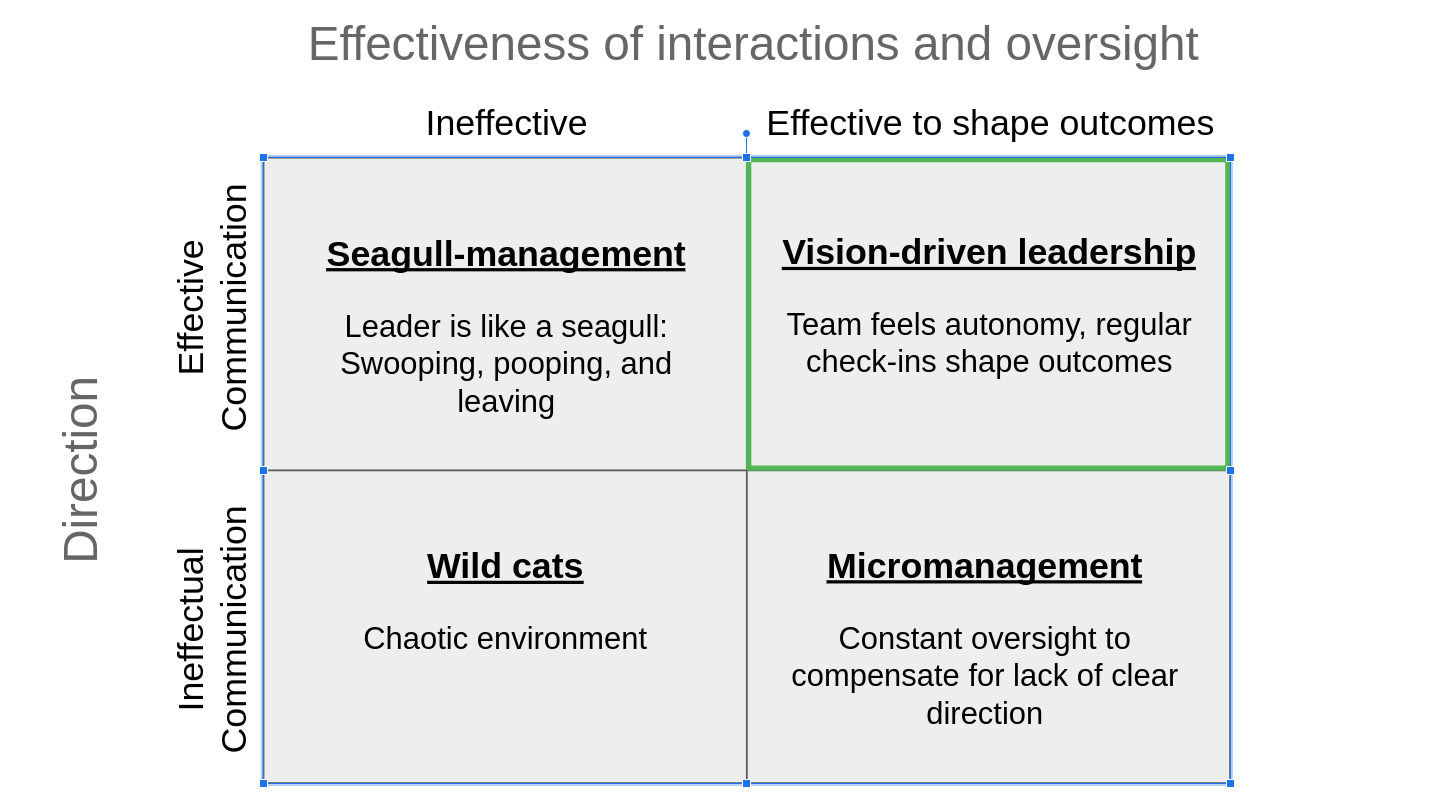What is Product Leadership?
Product leadership means scaling your thinking and spreading your influence across the organization to translate your vision into reality. To accomplish this, when making product decisions, instead of making all the decisions for your team, you align your team on the direction by communicating effectively and help them develop a strong intuition for making the right decisions. Good product leaders strive to make their role irrelevant - when your team is autonomous and makes decisions like you would even when you’re on vacation, you can pat yourself on the back for being a great product leader.
Can an individual contributor be a product leader?
Yes! Whether you’re an individual contributor or a manager, you’re a product leader if you exhibit the key traits of giving your team(s) the right balance of autonomy and direction.
What makes a good product leader?
Until now, most of us have had to figure out through trial and error what good product leadership looks like. It’s time to change that! This blog post offers a visual framework and a step-by-step process for developing the key skills you need to be a good product leader.
Essentially there are two dimensions to good product leadership:
- How effectively you communicate the direction to your team, and
- How effectively you interact with them to offer feedback and course corrections
When you do these two things just right, you’re able to give your team the autonomy they need and yet you have enough influence to be able to shape the output.
When you plot these two dimensions, the following styles of leadership emerge. See if you recognize these styles:
A visual framework for product leadership

- Wild cats: When the leader hasn’t communicated the direction clearly and also doesn’t have time to interact with the team frequently, it leads to a chaotic environment where everyone is busy, but running in different directions. It’s hard to get anything done in this environment.
- Seagull-Management: When the leader communicates the direction effectively but then is largely inaccessible, the team might work on something for a long time, but it turns out to not meet the leader’s expectations. When the leader sends the team back to the drawing board after all the hard work, teams feel demoralized and perceive this as the seagull-style of management: swooping, pooping, and leaving.
- Micromanagement: When leaders don’t communicate the direction effectively, they sometimes compensate with excess oversight and getting involved in every decision. While micromanagement has been glamorized over the last decade, research shows that companies that offer autonomy are 10 times more likely to outperform traditional organizations in the short term and more than 20 times more likely to outperform them in the long term.
- Vision-driven leadership: You’re communicating effectively and interacting at just the right frequency. Your team buys into the vision and feels a sense of shared purpose. They have autonomy in making decisions and they interact with you frequently enough so you can shape the outcome and remove obstacles when needed. This is the quadrant you’re aiming for in product leadership.
How do you develop product leadership skills?
Good product leadership requires skills on both dimensions of the 2x2 framework above. This means giving your team the level of interactions they need and communicating the direction effectively. Here is a 5-step guide to help you get better on both dimensions:
Interacting effectively with your team:
1. Meet with your team at the frequency they need:
Think about how often you have 1:1 meetings with your direct reports. If you’re an individual contributor, think about how accessible you are to your team and how often you speak with them to share your rationale behind a decision or a feature. As a product leader, the 1:1 interactions and the genuine connection formed in those meetings is key to being able to shape outcomes.
Remember that this means that the interactions must feel like a give and take. If in the 1:1 interactions team members feel like they’re reporting updates but get little in return, these interactions become a chore for them. Just as you need updates from them, ask what they might need from you. Perhaps they need advice, help in securing stakeholder support on an issue, or just your moral support as they take a stand.
2. Create a dialogue (which requires psychological safety):
Good product leadership means creating psychological safety for your team. High-performing teams exhibit learning behavior, i.e. they talk about mistakes, understand what went wrong, and take individual risks to improve outcomes. All of this requires feeling like you have the safe space to make mistakes in the process of trying to do better.
To create psychological safety for your team, demonstrate that it’s OK to make mistakes. If you make a mistake, set an example by saying openly that you were wrong and what you learnt from it. Create an environment where team members care genuinely about each other and therefore speak up when they feel like something can be improved and give each other honest feedback that is delivered in a considerate and generous manner.
Strive to make every interaction effective, where you create a genuine connection and both parties get an insight into the other’s way of thinking.
Communicating effectively with your team:
3. Give clarity on your vision:
When the vision is unclear, it’s hard for team members to have an intuition for making the right decision. A broad vision statement such as “To be the leader in data storage” or “Enabling human progress by empowering people express themselves” doesn’t give clear direction on what problem you’re setting out to solve or the end-state you envision. A good product leader paints a clear picture of what the world looks like when you can say “mission accomplished.” It’s hard to write such a vision statement when starting with a blank sheet of paper. Instead, you can download the free Radical Product Thinking Toolkit to craft a detailed vision.
4. Scaling your thinking (sharing how you make tradeoffs):
It’s easier to be empowered when team members know how their leaders think and understand their rationale. Even as you read this, your team members are most likely making trade-offs between the long term and the short term through their own work. A software developer could choose to spend time carefully building software for the long term or could write code quickly to deliver something in the short term and undertake major repairs later.
Instead of dictating the right tradeoffs, you scale as a leader when you spread your thinking across the organization by developing in others the same intuition you have for decision-making. The Radical Product Thinking approach to prioritization helps you visualize and communicate these tradeoffs on two axes: Vision (long-term) vs. Survival (short-term). When you use this approach to share your rationale for decision-making, you won’t need to micromanage because you’ll be influencing others to make decisions like you would, even when you’re not around.
5. Create alignment on how you measure success:
A good product leader aligns the team on what metrics indicate whether the product is successful, and then manages progress through regular feedback.
Although OKRs were intended to create alignment by quantifying the impact the organization strives to create, they come with serious side effects. Studies have found that on a complex task where the right answer wasn’t obvious and when performance was more a function of strategy than of brute force or repetition, do-your-best instructions led to better results than specific goals. In such cases, they found that specific goals may discourage experimentation and adaptive behavior and ultimately limit innovation. The process of building a product is filled with uncertainty where there are few right answers. As a result, creating alignment by setting goals or OKRs for product metrics is particularly contraindicated.
Instead, to align your team on how you measure success, start by co-creating a clear vision and strategy. Next for each element in your vision and strategy, list the key metrics that would indicate progress. Instead of targets, for each element in your vision and strategy, think about what you’d measure to answer for yourself whether that approach is working. Plan regular feedback sessions where you openly discuss product metrics and which metrics you want to optimize for.
Your communication is effective if it develops product intuition in your team so they have autonomy.
Conclusion
Irrespective of where you fall in the corporate hierarchy, you can level up as a product leader by working to be a vision-driven leader. These 5 steps help you develop your product leadership on both dimensions: how you align your team on your vision and rationale for decision-making, and how effectively you interact with your team to shape outcomes.
